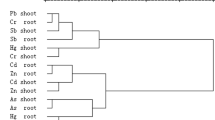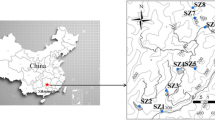Abstract
The absorption and accumulation of Pb, Zn, Cu and Cd in some endurant weed plant species that survived in an old smeltery in Liaoning, China, were systematically investigated. Potential hyperaccumulative characteristics of these species were also discussed. The results showed that metal accumulation in plants differed with species, tissues and metals. Endurant weed plants growing in this contaminated site exhibited high metal adaptability. Both the metal exclusion and detoxification tolerance strategies were involved in the species studied. Seven species for Pb and four species for Cd were satisfied for the concentration time level standard for hyperaccumulator. Considering translocation factor (TF) values, one species for Pb, seven species for Zn, two species for Cu and five species for Cd possessed the characteristic of hyperaccumulator. Particularly, Abutilon theophrasti Medic, exhibited strong accumulative ability to four heavy metals. Although enrichment coefficients of all samples were lesser than 1 and the absolute concentrations didn’t reach the standard, species mentioned above were primarily believed to be potential hyperaccumulators.


Similar content being viewed by others
References
Deng H, Ye ZH, Wong MH (2004) Accumulation of lead, zinc, copper and cadmium by 12 wetland plant species thriving in metal-contaminated sites in China. Environ Pollut 132:29–40
Eapen S, Dsouza SF (2005) Prospects of genetic engineering of plants for phytoremediation of toxic metals. Biotechnol Adv 23:97–114
Ertli T, Marton A, Foldenyi R (2004) Effect of pH and the role of organic matter in the adsorption of isoproturon on soils. Chemosphere 57:771–779
Fitzgerald EJ, Caffrey JM, Nesaratnam ST, McLoughlin P (2003) Copper and lead concentrations in salt marsh plants on the Suir Estuary, Ireland. Environ Pollut 123:67–74
Garbisu C, Alkorta I (2001) Phytoextraction: a cost-effective plant-based technology for the removal of metals from the environment. Bioresour Technol 77:229–236
Heberger K, Csomos E, Simon-Sarkadi L (2003) Principal Component and Linear Discriminant Analyses of Free Amino Acids and Biogenic Amines in Hungarian Wines. J of Agric Food Chem 51:8055–8060
Kabata-Pendias A, Pendias H (1984) Trace Elements in Soils and Plants. CRC Press, Florida. 52 pp
Kim IS, Kang KH, Johnson-Green P, Lee EJ (2003) Investigation of heavy metal accumulation in Polygonum thunbergii for phytoextraction. Environ Pollut 126:235–243
Kra¨mer U (2005) Phytoremediation: novel approaches to cleaning up polluted soils. Curr Opin Biotechnol 16:133–141
Meagher RB (2000) Phytoremediation of toxic elemental and organic pollutants. Curr Opin Plant Biol 3:153–162
Morikawa H, Erkin OC (2003) Basic processes in phytoremediation and some applications to air pollution control. Chemosphere 52:1553–1558
Pichtel J, Kuroiwa K, Sawyerr HT (2000) Distribution of Pb, Cd and Ba in soils and plants of two contaminated sites. Environ Pollut 110:171–178
Ren HM, Wang JD, Zhang XL (2004) Spatial distribution of Pb in soils and it’s risk assessment in Shenyang city. Advance in Earth Sciences 19:429–433 (in Chinese)
Río MD, Font R, Almela C, Vélez D, Montoro R, Bailón ADH (2002) Heavy metals and arsenic uptake by wild vegetation in the Guadiamar river area after the toxic spill of the Aznalcóllar mine. J Biotechnol 98:125–137
Salt DE, Smith RD, Raskin I (1998) Phytoremediation. Annu Rev Plant Physiol Plant Mol Biol 49:643–668
Terrab A, Hernanz D, Heredia FJ (2004 Inductively Coupled Plasma Optical Emission Spectrometric Determination of Minerals in Thyme Honeys and Their Contribution to Geographical Discrimination. Journal Agri and Food Chem 52:3441–3445
Wang X, Zhou QX (2003) Distribution of forms for cadmium, lead, copper and zinc in soil and its influences by modifier. Journal of Agro-Environment Science 22:541–545. (in Chinese)
Wei SH, Zhou QX (2004) Identification of weed species with hyperaccumulative characteristics of heavy metals. Progress in Natural Science 14:495–503. (in Chinese)
Wei SH, Zhou QX, Zhang KS, Liang JD (2003) Roles of rhizosphere in remediation of contaminated soils and its mechanisms. Chinese Journal of Applied Ecology 14:143–147. (in Chinese)
Wei SH, Zhou QX, Wang X (2005) Identification of weed plants excluding the absorption of heavy metals. Environment International 31:829–834
Yin YJ, Impellitteri CA, You SJ, Allen HE (2002) The importance of organic matter distribution and extract soil: solution ratio on the desorption of heavy metals from soils. Sci Total Environ 287:107–119
Zhou QX (2002) Technological reforger and prospect of contaminated soil remediation. Techniques and Equipment for Environmental Pollution Control 3:36–40. (in Chinese)
Zhou QX, Huang GH (2001) Environmental Biogeochemistry and Global Environmental Changes. Science Press, Beijing. 85pp. (in Chinese)
Zhou QX, Song YF (2001) Technological implications of phytoremediation and its application in environmental protection. Journal of Safety and Environment 1:48–53. (in Chinese)
Zhou QX, Song YF (2004) Principles and Methods of Contaminated Soil Remediation. Science Press, Beijing. 75 pp. (in Chinese)
Zu YQ, Li Y, Christian S, Laurent L, Lin F (2004) Accumulation of Pb, Cd, Cu and Zn in plants and hyperaccumulator choice in Lanping lead-zinc mine area, China. Environ Int 30:567–576
Zu YQ, Li Y, Chen JJ, Chen HY, Qin L, Schvartz C (2005) Hyperaccumulation of Pb, Zn and Cd in herbaceous grown on lead–zinc mining area in Yunnan, China. Environ Int 31:755–762
Acknowledgment
The authors acknowledge the financial support from the Natural Science Foundation of China as a project for Distinguished Young Scholars (No. 20225722). This work is also a component part of the key basic research development and planning (973) project (No. 2004CB418503) that was supported by the Ministry of Science and Technology, the People’s Republic of China.
Author information
Authors and Affiliations
Corresponding author
Rights and permissions
About this article
Cite this article
Cui, S., Zhou, Q. & Chao, L. Potential hyperaccumulation of Pb, Zn, Cu and Cd in endurant plants distributed in an old smeltery, northeast China. Environ Geol 51, 1043–1048 (2007). https://doi.org/10.1007/s00254-006-0373-3
Received:
Accepted:
Published:
Issue Date:
DOI: https://doi.org/10.1007/s00254-006-0373-3




